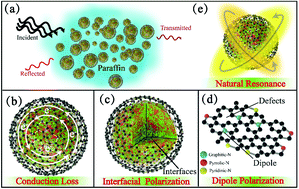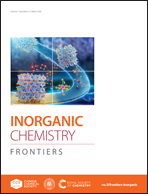Nitrogen-doped graphene layer-encapsulated NiFe bimetallic nanoparticles synthesized by an arc discharge method for a highly efficient microwave absorber†
Abstract
The development of inexpensive yet high-performance microwave absorbers to attenuate electromagnetic pollution stemming from the wide application of various electrical devices is of great significance. Magnetic NiFe alloys with relatively high permeability and multiple magnetic resonances are advantageous to broaden the absorption bandwidth. Benefiting from the coatings of carbon materials, the NiFe@C composites can efficiently increase the capability of oxidation/corrosion resistance. Meanwhile, the formation of numerous hetero-interfaces between C and NiFe alloys leads to interfacial polarization. However, it is still difficult to couple their relatively strong dielectric loss with magnetic loss, resulting in impedance mismatching. In this work, NiFe alloy nanoparticles embedded in nitrogen-doped graphene layers are successfully fabricated under a mixed gas of CH4/N2/Ar. By controlling the number of graphene layers and nitrogen doping level, the overall impedance can be effectively ameliorated. Experimental results indicate that the minimum reflection loss (R) can reach −46.89 dB at 11.96 GHz, accompanied by an effective absorption bandwidth of more than 4.1 GHz. Our work will advance the study of magnetic alloys/N-doped graphene composites for microwave absorption.



 Please wait while we load your content...
Please wait while we load your content...